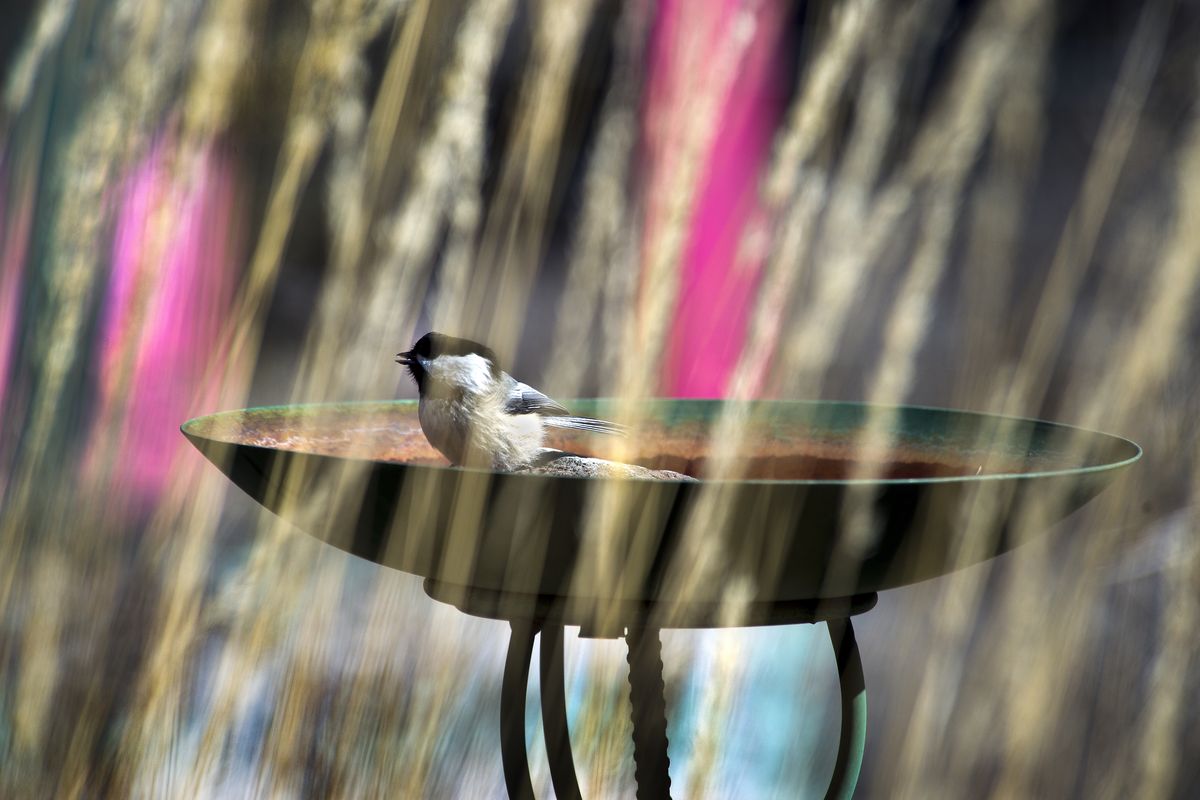In the Garden: Food, water, protection and nesting sites attract birds

Gardens teem with life: earthworms work their miracles in the soil, beetles crawl about industriously, ladybugs munch aphids for us and butterflies add flashes of color to the flower beds.
But some of the most delightful garden visitors are birds. Watching them brings a sense of wonder to our surroundings: we see how they interact, watch them eat, witness their aerial acrobatics and marvel over their young when they appear on the scene.
Longtime birdwatcher and Master Gardener Laren Sunde shares this delight at seeing birds in her garden. She and her husband Ed Winkey live on about 30 acres near Spangle, and they’ve worked hard to make their garden as attractive to birds as possible.
“We call birds our garden ornaments because of the color and the life they bring. They sing so very pretty, we love listening to them,” Sunde said. “And watching a baby bluebird taking a bath is hilarious,” she added.
During the winter, bird visitors to their garden include juncos, northern flickers, pygmy and white-breasted nuthatches, brown creepers, mountain and black-capped chickadees, quail, magpies and jays. They’ve also seen some interesting raptors like great horned owls, merlins and peregrine falcons.
Now that spring is here, they’re starting to see western bluebirds, red-winged blackbirds, spotted towhees, robins and ruby-crowned kinglets.
For birds to come to a garden, they need food, water, protection and nesting sites.
When the couple moved into their home in 2001, the perimeter of the yard had a variety of shrubs, but there wasn’t much vegetation that would attract birds. One of the first things she did was to plant native shrubs such as Oregon grape, serviceberry and chokecherry as well as native annuals.
In “Gardening for the Birds,” author George Adams emphasizes just how important this is:
“In creating your garden to attract birds, first and foremost I recommend that you use plants that are native to your region, because those plants are most likely to meet the needs of your local bird species.”
Sunde chose plants that produce berries – mountain ash, serviceberries, currants, crabapples, sumac and red twig dogwoods, for example –because they attract robins, Bohemian and cedar waxwings, yellow-rumped warblers and the occasional Bullock’s oriole.
Other examples of native plants that bloom and produce fruits are elderberry, buffaloberry, snowberry, twinberry (bearberry) and thimbleberry.
But she didn’t stop there. She wanted to add plants that would provide seeds or nectar for birds as well.
“One major thing I did was lessen the amount of lawn and transform that area into a perennial garden,” Sunde said. “I added coneflowers, asters, columbines, sedums, lavender, coral bells and lots of herbs.”
She doesn’t use pesticides and rarely uses herbicides. She also recommends leaving part of your garden in its natural state.
“Even in the city, leave a corner of your property as natural as possible,” she advised. “Leave the leaf cover, let the grass grow a little taller and leave seedheads for birds to eat during the winter.”
Another important consideration to keep the birds coming is to make sure they have fresh water every day.
“I have five birdbaths and two whiskey barrels,” Sunde said. “The barrels are at ground level and I’ve stacked bricks and rocks inside them so birds can drink and bathe safely.”
She recommends keeping the birdfeeders and birdbaths clean to help birds stay healthy.
When it comes to feeding wild birds, Sunde supplements their natural diet during the winter. She prefers seed-and-nut suet over fruit suets as the latter are artificially flavored. Black-oil sunflower seeds are her favorite since birds seem to like them the most.
“I don’t put out seed year-round, mostly during fall and winter, and then again in the summer to get the bird families coming in,” she explained. She also puts out seven hummingbird feeders during the summer months.
Sunde believes evergreens are ideal for providing birds with shelter from predators and for winter protection. She also suggests putting up birdhouses to attract wrens or bluebirds.
Her final words of wisdom?
“Always have a bird book and binoculars on hand at all times, both in the house and outdoors,” she said. “You just never know when you’ll need to identify something new.”